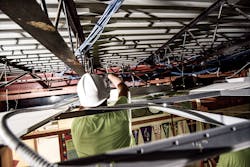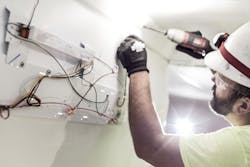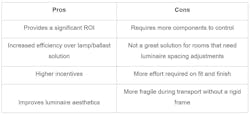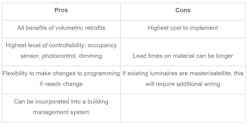Implementing a lighting project today doesn’t have the same considerations as the lighting retrofits of 10 years ago. In those days, you could simply evaluate options like choosing lower wattage lamps, eliminating luminaires, or adding occupancy sensors. Now, in addition to these options, you must compare multiple LED lamp replacement solutions to volumetric retrofits or new luminaires — and that doesn’t begin to address the variety of control packages. Add to that the selection of your designer, manufacturer, budget, etc., and it can definitely seem overwhelming.
Faith Technologies works with many facility teams who are struggling with decision making. As a contractor, there are several steps you can take to guide your customers through the best approach to lighting design and implementation that will ensure you meet their goals and expectations. The first step in that process is helping them find a trusted lighting designer.
Today, there are more lighting specifiers than ever before, and all are not created equally. There are architect or engineering firms, energy service companies (ESCOs), turnkey providers, or lighting designers. Each has varying degrees of credentials and experience, and what may be right for one lighting project may be wrong for another. Consider the following:
- Architect and engineering firms are suitable for projects that involve the construction redesign of space.
- ESCOs take a more holistic project approach, specializing in energy-related redesigns that tackle multiple solutions. For example, if your client is looking to upgrade its lighting, add a rooftop solar array, and install a more efficient boiler system, an ESCO can be a “one-stop-shop” for this work, providing lighting solutions that integrate seamlessly with a larger construction or energy-efficiency scope.
- A turnkey provider can complete both design and installation of the lighting system.
- Although “lighting designer” is a broad title, it refers to companies that are designing the system but not installing it with their own installation crew. They create the scope of work and either allow the end-user to select the installing contractor or hire a third-party installation crew.
The scope of the project helps determine whether an architect or ESCO is necessary based on the customer’s goals.
A facility owner/manager must consider the following items when choosing between a turnkey provider and a lighting designer.
- Experience: How long has the company been in the lighting retrofit industry? We are seeing an explosion of companies pop up over the last few years that saw the market shift and are taking advantage of the fact that almost anything LED will save energy over traditional lighting systems.
- References: Do they have a list of references and information about past projects that implemented a scope of work similar to what you are trying to accomplish, as well as others that may not be related in scope? It is important that designers have experience in many types of LED projects so they can address the variety of luminaires you have in your facility. If you are considering a network lighting solution, for example, do you want your project to be their first? Reach out to their references, and ask how easy they were to work with/how they managed the project.
- Partnerships: Some companies will only quote third-tier manufacturers because they know they are sold at a lower price point, which means a quicker return on investment (ROI) and a higher likelihood of a sale. Beware! The adage “You get what you pay for” certainly applies to lighting products. Many of the manufacturers that were created in the last few years are not actually manufacturing their own products. They buy a no-name panel, add a private label, and call it their own. Then they tout a “10-year warranty” and vanish right around the time you need support. Look for a company that partners with first-tier manufacturers (i.e., leaders in the industry) and has a track record of working through warranty issues and making things right.
- Financials: The company’s financial stability is important because your designer is the last line of defense when a warranty issue arises. When considering your design firm, does it have the financial standing to cover anything the manufacturer does not?
- Installation: Evaluate the installation crew as well as the design/project management team. If the design team and install crew are part of the same company, it will simplify the process and enable one line of communication between you, the designer, and the installation crew.
- Safety: It is important to ensure the safety records of your chosen designer. Ask questions of those who will be in your facility when nobody else is around or who will be working around your staff. How do they approach safety? The answers to these questions can have a direct impact on the safety and well-being of your staff.
Digging into the details
The most significant influences on lighting design are typically cost and budget. Most companies want all the function and control of a network lighting system; however, many budgets only allow for retrofit kits. A good lighting designer will use a variety of techniques to meet your goals and budget. This may include network lighting in critical or high-use areas and standard retrofit kits in areas like hallways, break rooms, and restrooms. Faith Technologies always recommends implementing a higher level of technology in a smaller area rather than lower technology in more areas. Converting from fluorescent to LED lighting will be the last lighting project that generates a return on investment, so it’s important to get it right the first time.
Another consideration is how the room or area is used. An office would benefit from dimming controls and occupancy sensing for many reasons, whereas a hallway or cafeteria would not. In a school, the gym and auditorium can see great savings by adding scene control, but there is generally not a case for this functionality anywhere else in the building. Similarly, if an area has higher hours of operation, it is worth spending more budget dollars there over a space that is only used a fraction of the time or isn’t seen by the general public.
The condition of existing luminaires can also play a big part in the solution. It may seem more budget-friendly to swap out the components of luminaires with LED. However, by the time you replace broken or depreciated lenses, brittle or damaged sockets, and the lamp/ballast components, it may be more cost-effective to replace the luminaire completely.
Weighing the options
The following are some things to consider when recommending the best lighting upgrades for a facility.
Lamp/ballast replacement
Best suited for relatively new lighting — and in rooms that don’t have light level deficiencies — if the luminaire design is conducive. This is also a good solution for areas with low hours of operation.
Volumetric retrofit
This budget-friendly solution improves aesthetics and saves a significant amount of energy. It also puts less waste into the landfill.
Network lighting “smart” retrofits and/or new luminaires
Replacing existing luminaires with new luminaires that include networked lighting may be a higher initial price point, but they offer the most energy savings potential and the highest incentives. These luminaires allow occupants to easily control their lit environment.
There are hundreds of manufacturers that offer products that fit each category detailed above, and choosing the best manufacturer is a critical component of project success. Partnering with top manufacturers in the lighting industry helps you deliver a high-quality product to your customer that will serve them well in the future.
Financial focus
Compared to the days of fluorescent retrofits, LED lighting upgrades require a far greater upfront investment of financial resources. The good news is there are many ways to ease the impact on your business’ budget beyond the reduced monthly utility spend.
The first reduction is through rebate programs, such as Wisconsin Focus on Energy (FOE), and is based on the type of solution being installed. For example, for a linear ambient luminaire, a lamp replacement will bring in $1.25 per lamp; a new luminaire will bring in either $1/foot or $2.50/foot. If the luminaire includes network lighting, it will be based on the reduced wattage. If your budget leaves you just shy of being able to afford network lighting, then the incentives may help bridge the gap.
Tax credits can also impact project costs quite a bit, depending on what you qualify for. For tax-exempt clients, some lighting designers can apply for tax credits based on the square footage of the areas being upgraded. This can reduce project costs by almost 10%. For-profit companies are able to write off the full interior project costs from their annual taxes. While this isn’t an “instant discount,” it is worth the wait. If your corporate tax rate is 21%, you can plan to receive back 21% of the project costs through the Qualified Improvement Property (QIP) program.
It is also worth considering cost avoidance and maintenance savings — these are the dollars you would have spent on a relamp project (replacement bulbs and installation) or maintaining the current lighting system during the life of the alternative LEDs. Basic fluorescent lamps are rated to last 20,000 hours to 30,000 hours, whereas quality tubular LEDs (TLEDs) will maintain 70% of their output at 50,000 hours. Dedicated LED retrofits or luminaires are built to last with 70% output at 100,000 hours. Without an upgrade, how much of your operating budget will be spent on material costs and equipment rental to access the luminaires? What are the costs for maintenance staff to deal with lighting? Most facilities have more important items they could be addressing.
For organizations that still struggle to make the dollars work, consideration can be given to Lighting as a Service (LaaS). In this financial model, the energy savings generated by the upgrade pay for the project costs. For example, instead of monthly payments of $1,000 going to the utility, you pay $400 to the utility, and the $600 savings you realize goes toward project costs — similar to a lease. Faith Technologies offers this type of financing option, which can prove beneficial in many ways. Because we own the equipment, it is our responsibility to maintain it.
Back when a lighting upgrade meant a more efficient fluorescent system, projects were easily justified by their cost and energy savings. However, with LEDs having a higher initial project cost, be sure to consider the bigger picture as you decide what’s right for your business and your customers.
Carol West is an assistant project manager with Faith Technologies, Menasha, Wis. She is a Certified Lighting Efficiency Professional (CLEP).









